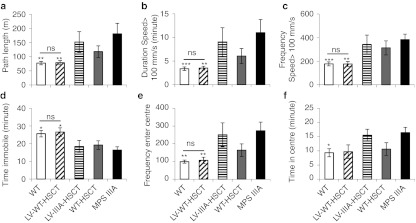Figure 5.
Lentiviral (LV)-wild-type (WT)-HSCT corrects behavior. The open-field behavior test was performed for one hour at the same point of the circadian rhythm at 6 months (24 weeks) of age (n = 10 female mice per group). The measures of hyperactivity were: (a) path length, (b) duration spent moving over 100 mm/s, (c) frequency spent moving over 100 mm/s, (d) duration immobile, while (e) frequency of centre entries and (f) duration in centre measures thigmotaxis and may be a measure of sense of danger. Error bars represent the SEM. Significant difference to mucopolysaccharidosis IIIA (MPS IIIA) is demonstrated with *P < 0.05, **P < 0.01, and ***P < 0.001. Where treatments result in significant improvement to MPS IIIA and there is no significant difference to WT this is shown by a line and ns. Groups were; WT untreated (WT), WT donor cells transduced with LV-SGSH into MPS IIIA recipients (LV-WT-HSCT), MPS IIIA donor cells transduced with LV-SGSH into MPS IIIA recipients (LV-IIIA-HSCT), WT to MPS IIIA (WT-HSCT), and MPS IIIA untreated (MPS IIIA). The copy number of the behavioral cohort was 0.27 copies per white blood cell for LV-WT-HSCT and 0.25 for LV-IIIA-HSCT.

